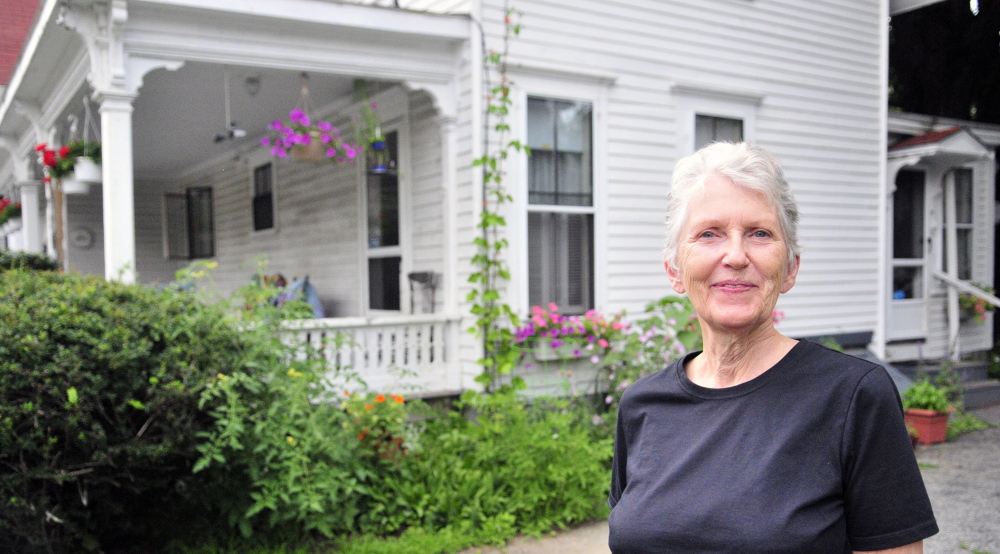AUGUSTA — Don Stratton, who lives in a white, gable-roofed house on Sewall Street, is a free spirit: He has a “door to nowhere” in his small backyard and said he’d like to retain the right to paint his house purple and green.
But that house has a plaque on it that says it was built around 1850, and it’s square in the middle of a new, sprawling historic district being considered by city councilors that would include the city’s downtown and Augusta’s premier 19th-century neighborhood in the area between Bridge Street and Western Avenue.
As the owner of one of more than 300 properties deemed historic in the district, Stratton would face the plan’s harshest restrictions. He could paint his house purple and green – the proposed ordinance exempts exterior painting – but other changes to his home’s exterior visible from the street, such as siding or window replacements, would have to be approved by a new review board.
Mayor David Rollins and other proponents of the district, which was proposed by the Augusta Historic Preservation Commission and is being considered by city councilors, say it’s a way to improve property values. Others say that it could increase costs of development. It’ll be discussed by councilors at an Aug. 13 meeting, but no vote is scheduled.
Stratton worries that the district could bring an “expansion of the sameness” in the varied area, which includes law offices, Victorian homes and blighted apartment buildings.
“The attitude I would like to see is that people are appreciative of the difference in their neighborhoods,” Stratton said.
The new district would include three existing areas on Winthrop, Crosby and Bond streets listed in the National Register of Historic Places. There are more than 140 of those districts in Maine, but they come with no property restrictions. Cities and towns can enforce those in separate local districts, and at least 35 Maine municipalities either have local historic commissions or boards that review designs in certain areas, according to the Maine Historic Preservation Commission.
Rollins said the district is an idea that dates back to the mayoral tenure of Sen. Roger Katz, who served from 2006 to 2010 and formed the City Council subcommittee that drafted the plan. Rollins is billing it as a way to increase property values in the long term. Studies across the country have borne that notion out, finding that property values in local historic districts rise faster than the rest of the market “in the vast majority of cases,” according to a 2002 paper from Donovan Rypkema, the head of a Washington, D.C., real estate and economic development consulting firm.
AA LONG-TERM COMMITMENT
“It’s not a sprint,” Rollins said. “It’s a long-term commitment, that’s for sure.”
But some aren’t sold. Councilor Jeffrey Bilodeau has raised concerns that it could be an intrusion into private-property rights. Landlords are divided on it, and while Rollins concedes that costs could go up for some developers to comply with historic standards, he says property owners will benefit from increased value and it’s “not necessarily going to add cost.”
Larry Fleury, one of the city’s biggest landlords, said earlier this year that it’s loose enough that most property owners should be OK with it; but Terry Berry of Gardiner, who owns two apartment buildings in the district, said it will add to the cost of improving buildings and could lead to increased rent that could price some out of Augusta.
“If the city of Augusta is concerned about affordable housing, they’ve got to stop adding layers of restrictions,” Berry said.
In 1959, Jeanne Davis moved to a historic home on Winthrop Street. Then, she said, it was “a wonderful place” where “your life could be within walking distance,” with the library, YMCA and downtown nearby. That was before much of the development now seen on Western Avenue and in north Augusta, when Water Street was still a commercial center.
It has changed since then, with many old single-family homes split into offices, but she supports the district proposal, citing a goal of “holding on to what we have in a reasonable way.”
“It does cost something to live here and not every family can swing that, but I think to have it encouraged is good,” she said.
However, even Davis said the district might be too big – apartment buildings on Crosby Street Place don’t match the stately homes in the district’s core – and it might be better to start smaller. Berry said he doesn’t think much of the apartment building stock is good enough to appreciate much in value over time.
Rollins said the district proposal would encourage property maintenance, and it eventually could make the neighborhood Augusta’s best.
“It was in its day, and it certainly can be again,” he said.
Michael Shepherd can be contacted at 370-7652 or at:
mshepherd@centralmaine.com
Twitter: mikeshepherdme
Send questions/comments to the editors.



Success. Please wait for the page to reload. If the page does not reload within 5 seconds, please refresh the page.
Enter your email and password to access comments.
Hi, to comment on stories you must . This profile is in addition to your subscription and website login.
Already have a commenting profile? .
Invalid username/password.
Please check your email to confirm and complete your registration.
Only subscribers are eligible to post comments. Please subscribe or login first for digital access. Here’s why.
Use the form below to reset your password. When you've submitted your account email, we will send an email with a reset code.